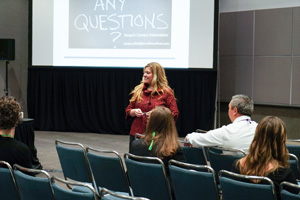Liberal Arts Power What It Is and How to Sell It
Selling a Liberal Arts Instruction in a Stem Globe

With the emerging focus on STEM/STEAM training and educational activity, a liberal arts didactics has fallen out of favor with politicians, parents, students, and media. That popularity shift may be due, in function, to a misconception about skill need and employment potential, as well as a fundamental misunderstanding of what a liberal arts education entails.
In her Monday session at the Annual Meeting, Dr. Jacquelyn D. Elliott, President, enrollmentFUEL, and Chief Enrollment Specialist with Marion Military Institute (every bit well as 2019 Recipient of AACRAO's Award for Excellence in International Education), talked with attendees almost how to define, package, and sell a liberal arts didactics.
Often, people believe that liberal arts graduates can't become jobs, and that liberal arts is a dying field, she noted. They believe students demand a STEM field major because engineering science is where the opportunity is. However, Elliot said, that supposition is based on a misapprehension of what liberal arts means and what employers want.
What are liberal arts?
"Part of the problem is that families don't understand what 'liberal arts' means," Elliott said. "We have a task in the messaging. How do we clarify and practise a better chore telling them."
Liberal arts isn't a single discipline, it'south a program of education. Rather than developing specialized noesis in a single field, liberal arts degrees require students to obtain a wide base of general pedagogy in a multifariousness of fields, including language arts, mathematics, and social and physical sciences. It doesn't exclude disciplines such as engineering or computer science, only rounds them out with a wider range of educational experiences. This allows for integrative, innovative thinking and professional advancement.
What employers want
Despite the media focus on growth in the tech sector, employers go on to value skills that can be acquired through liberal arts programs but not through Stem specialized programs, including:
-
93% say demonstrated capacity to recollect critically, communicate clearly and solve complex problems is more of import than the major
-
More than ix in ten say they must hire someone who can demonstrate upstanding judgment and integrity, intercultural skills, and want for connected learning
-
lxxx% of employers agree that regardless of major, every student needs a broad knowledge of liberal arts and science
"Narrow learning is not plenty," Elliott said. "If nosotros tin shape our messaging and marketing around what employers really desire, we tin can help turn the corner."
Professional development potential: The 'wow' moment
In discussion nearly how to develop messaging that conveys these truths, ane audience member noted that her institution strives to "prepare students for lifetime vocation, not just their first job."
That messaging is on point for marketing liberal arts degrees, Elliott noted, because skills developed through liberal arts are those that prepare students for promotion and advancement.
Mobility potential. Elliott described the following revelation equally a 'wow' moment for many prospects: "About employers believe Stalk majors are prepared for entry-level positions, while liberal arts are prepared for advancement in the career."
Although STEM majors may make more money right out of school, over their lifetime, liberal arts majors brand an average of $twoscore,000/year more during their superlative earning years, considering their pedagogy has prepared them to develop into leadership and direction roles, rather than staying in technical roles. The do good of a liberal arts degree is career mobility, not stability.
"Liberally-educated people redefine themselves and move up the ladder because they have wide skill prepare to draw upon across their careers," Elliott said.
And, in fact, 70 pct of STEM caste holders are not employed in a Stalk-related field, undermining the claim that Stalk specialties are easy funnels into employment.
Rapport sector. In improver, liberal education skills are in very loftier demand in the electric current economy.
"The rapport sector or empathy economic system is creating most jobs in the U.S. correct at present," Elliott said. "That's heavily dominated past liberal arts." Citing the book You Can Do Anything: The Surprising Power of a "Useless" Liberal Arts Teaching past George Anders, Elliott described the example of Open Table, the online eating place reservation service. To run the app requires only xiv people in technical positions but 100 people with expertise in communication.
"There's a huge demand for people who can humanize technology," Elliott said. That doesn't hateful we don't need Stalk folks, just that the two skills go hand-in-paw.
What are you doing to sell to families?
Elliott offered recommendations for those seeking students interested in liberal arts, including:
-
Purchase those names specifically and tailor/segment your messaging appropriately.
-
Focus on benefits (non features) of education. For example, if you have a summit-rated facility, convey how that benefits your students.
-
Emphasize the scaffolding power of co-curricular experiences (such as having learning outcomes for residential life) to back up liberal education.
-
Know your statistics, sympathise the research, and believe in the power of liberal teaching.
Source: https://www.aacrao.org/resources/newsletters-blogs/aacrao-connect/article/selling-a-liberal-arts-education-in-a-stem-world
0 Response to "Liberal Arts Power What It Is and How to Sell It"
Post a Comment